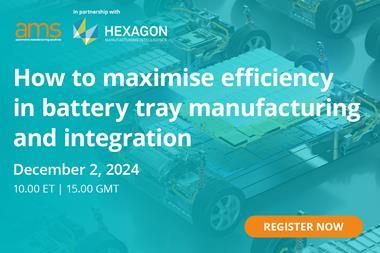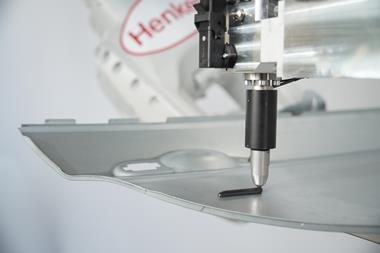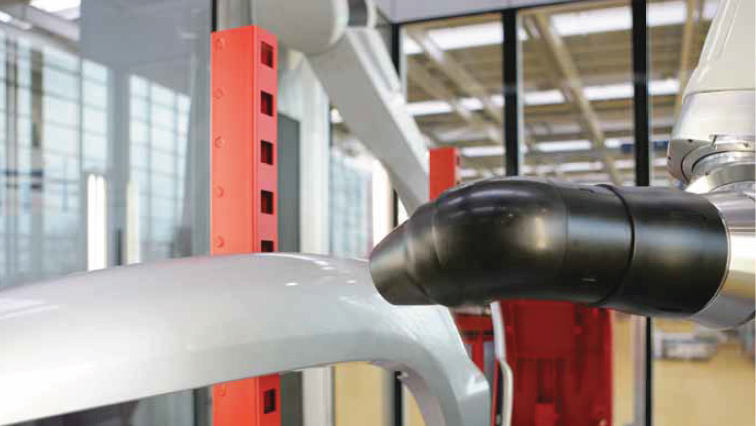
Eisenmann has been working hard to meet the challenges of today’s paintshop according to Ralph Meier, head of the company’s Application Technology Research Division
Among the new systems recently introduced by the company, its VarioCharger technology shortens both distance and time from the material store to the applicator bell or atomizer, as Ralph Meier says: “VarioCharger is an economically attractive solution for our customers, which also meets the highest standards in coating quality and efficiency. The system also minimizes paint losses and shortens downtime when changing colours.”
Reducing cost in paint use and maintenance
Modern finishing technology would be inconceivable without high-voltage paint application, due to its many advantages, such as more uniform application of paint and higher throughput. The ecologically desirable use of water-borne and 2-pack paints also requires paint metering systems based on the principle of potential isolation to prevent short-circuiting. Depending on the system used, this has so far been associated with high paint losses when changing colours, long distances between pump and atomizer and/or considerable maintenance effort. Thus the objectives when developing the VarioCharger were to minimize paint losses when changing colours while at the same time ensuring more accurate metering of the paint quantity. Other objectives included a reduction in maintenance effort and wearing parts, as well as ensuring first-class painting performance with high flow rate and painting speed.
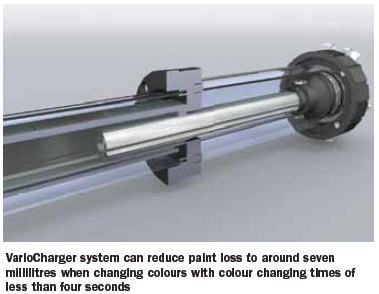 Parallel power in paint lines
Parallel power in paint lines
VarioCharger comprises two metering cylinders connected in parallel. They control the process steps of filling, painting and rinsing. While one cylinder is filling and rinsing, the other supplies the painting robot with paint. Without colour changes, painting can continue in this way with an unlimited supply of paint. When changing colours, the cylinder in use must be rinsed before being refilled. Unlike conventional metering systems, the VarioCharger does not deliver the paint via pigs, but only with the aid of the rinsing agent. Only the filling line used by both metering cylinders operates with a single pig so that it can be serviced more easily. In the rest of the system, the paint column is forced through the line between two columns of rinsing agent.
Rinsing agent and paint are cleanly separated by the patented piston technology in the metering cylinder. Precise linear movement of the piston in the cylinder is ensured by a ball screw, driven by a servomotor via a synchronous belt drive. In this way, the paint column can be drawn into the metering cylinder in the same way as into a syringe and also ejected from the cylinder for application. Since the servomotor, toothed belt and feed module operate with high precision, the amount of paint and rinsing agent can also be precisely metered. This in turn minimizes the paint loss when changing colours.
Less paint lost and rapid colour change possible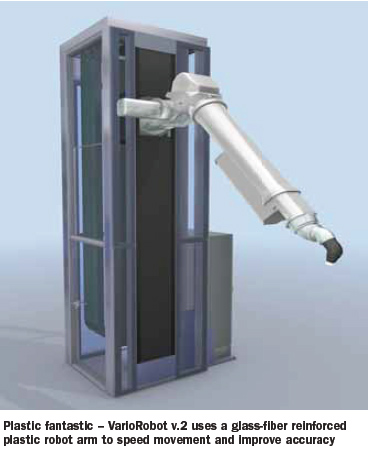
Thanks to the metering accuracy of the VarioCharger, paint loss when changing colours can be reduced to approximately 7 milliliters (ml). Compared to the average colour loss of 50 ml when using conventional systems, this yields paint savings of roughly 86% per rinsing operation. In addition to protecting the environment, users can save on every colour change, as less paint is rinsed out and rendered unusable. Since the metering cylinders are arranged in parallel, one system can be filled while the other is painting. It is therefore ready to use as soon as the first system has been completely emptied. This results in efficient colour changing times, of less than four seconds.
Precise measurement can be made in paints of different viscosity due not only to the reduction in wearing parts, such as paint pumps, measuring cells and pigs, but also as a result of the considerable reduction in sensor systems. Process sequences can be simplified and control effort reduced as a result. In addition, the VarioCharger’s modular design allows it to be integrated into the commercially standard painting robots made by different manufacturers.
Inside and outside
Eisenmann has been at the forefront of high-speed rotary atomizer application technology with its VarioBell system and has made many breakthroughs in air forming and guiding spray patterns for efficient and highly targeted use of paint. With the widespread adoption of water-borne paints, and the increasing complexity of automotive structures, the company has been working hard to keep pace with innovations in materials and processes.
“The second generation of our VarioBell (v.2) is a new highspeed rotary atomizer for wet paint application which focuses on efficiency and user-friendliness,” says Ralph Meier. Fitted with a double guiding and forming air system, the v.2 can adapt its spray jet to virtually every type of workpiece and is therefore equally suitable for interior and exterior applications. This technology not only guarantees high efficiency, but also a high quality of coating, even when painting at high capacity. The system also gives installations easier handling, cleaning and maintenance.
The v.2 is one of the smallest painting bells on the market. With its slender form and low weight of roughly 4.2 kg, it is particularly suitable for painting complex cavities and undercuts. The VarioBell system was developed for electrostatic application of both water-borne paints and conventional paint systems.
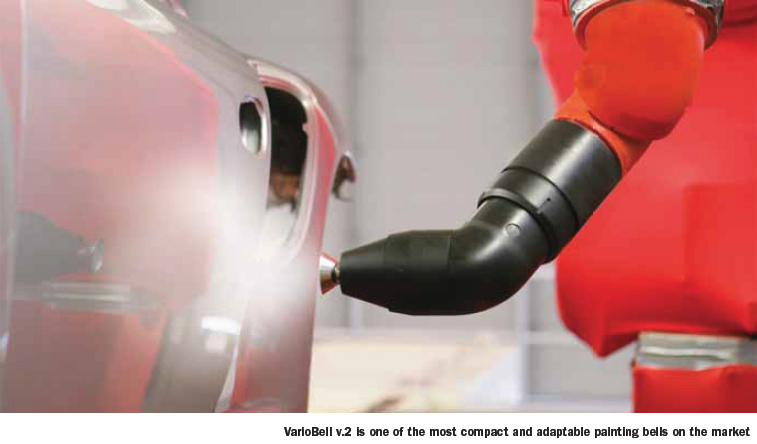 Adaptable and agile
Adaptable and agile
The double guiding and forming air system allows the spray jet to be adjusted over a large range, from 50 to 350 mm in diameter. In this way, the atomized spray jet can be optimised to paint the workpiece, with the aid of the guiding and forming air. Applications range from door openings or recesses in plastic bumpers on vehicles, for which a slender spray jet is needed, to large surfaces, such as bonnets or plastic hang-on parts.
The powerful high-voltage cascade integrated into the bell has always been the hallmark of Eisenmann’s high-speed rotary atomizer technology. High-efficiency application is ensured by the carefully controlled constant voltage of up to 100 kV and a maximum current of 350 μA, creating ideal conditions for the application of water-borne paints. The VarioBell v.2 is also based on this principle.
Paint losses when changing colours are minimized by the combination of a two-channel paint tube with micro paint valves located directly behind it. The bell plate is also cleaned internally without loss of paint. In addition, the turbine performance has been increased to 100,000 revolutions per minute in the new v.2, with the result that up to 800 cm³ of paint can be applied within a minute.
Light weight and high efficiency
Where in the past, robots in paintshops have been the preserve of one of the major robotics manufacturers, Eisenmann has sought to challenge this monopoly with its flexible and lowoperating- cost VarioRobot coating robot. VarioRobot has been updated and improved , as Ralph Meier, explains: “Even on the second version of the VarioRobot, we remained faithful to the Clean-Wall concept so that we would still be able to reduce the booth width to further help reduce operating costs”. With this Clean-Wall concept, only the easy-to-clean process arm projects into the spray booth and all mechanical parts are accommodated outside the booth for easy maintenance.
Lightweighting the robot arm
Thanks to ultra-modern production methods involving the use of glass-fiber reinforced plastic, the company has managed to increase the rigidity of the process arm whilst keeping its dead weight low. This means that it remains extremely steady while following the often jerky system movements and is thus able to apply coatings more precisely. In addition, the reduced weight allows faster movements, thus helping speed process times. Not only the robot arm but also the overall system has been modified for greater rigidity. The reason for this is the counterweight of the lift axis that runs in the central lift column, this ensures a smoother upward and downward movement.
In the new design, a clear separation was made between the kinematic system and the application system and so the colour changer of the VarioRobot v.2 is now arranged outside the process arm for easy maintenance. It is located on a new, large attachment area, designed specifically for the application system. This is where the ideal application configuration can be implemented, depending on application.
Space-saving interfacing simplifies maintenance
The VarioRobot v.2’s rotary axis features a new drive concept, allowing the diameter inside the second axis to be increased. This means that there is more space for the paint supply lines running inside it. Overall, this means that the system is more maintenance-friendly and that material wear is substantially reduced. A simplified control-cabinet concept on the robot and coating-application control saves space, along with placing the application hardware in a common robot cabinet, connected directly to the robot.






























